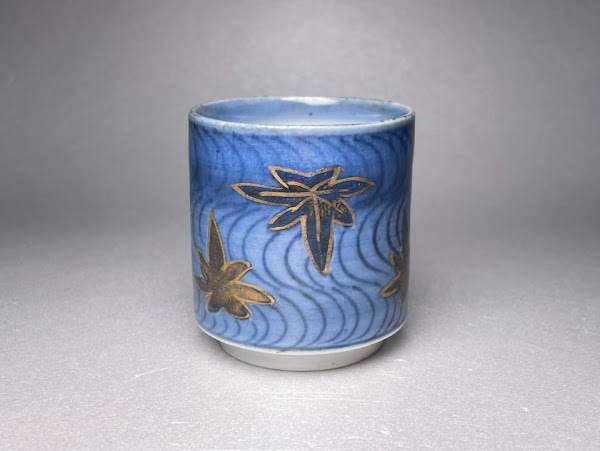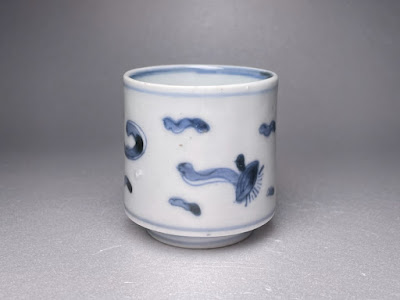目白コレクション 2022春 Mejiro Collection Antique Fair
目白コレクションという、全国から40店以上の、おもに和骨董商が参加する古美術品の展示即売会にいってきた。
I went to an antique exhibition held in Mejiro, Tokyo, where more than 40 dealers from every part of Japan showed mainly Japanese old things.
金彩染付 のぞき猪口 流水楓文 Stream and Maple Leaves
口径 top width: 52 mm / 高さ height: 55 mm / 高台径 bottom width: 40 mm
川の流れとそこに浮かぶ楓6枚がダミで表現され、さらに葉っぱは金彩で装飾される。紅葉した楓の流れゆくさまが見事に表現されているとおもう。手にとるとやや重さを感じる。
Water stream and six maple leaves are expressed with cobalt blue glaze and the leaf is decorated with gold. I think that red maple leaves drifting down a stream are well described. It feels a bit heavier than it looks.
染付 のぞき猪口 鯉の滝登り図 A Carp Becoming a Dragon
口径 top width: 51 mm / 高さ height: 54 mm / 高台径 bottom width: 38 mm
雲の切れ間を竜が飛んでいる。達筆すぎて絵柄がなにをあらわすのかいまいち不明の部分があるが、魚の尾びれのようなものがくっついているので、これは鯉が竜に化けるという龍門の鯉の故事に関係するものだろう。裏側と見込みとに、なにかタワシのようなものにチンアナゴみたいな細長いものが乗っている文様が描かれるが、これも故事にまつわるものなのだろうか。縁にニューがあったが、珍しい絵柄なので入手した。
A dragon flies through clouds. As something like a fish tail is attached to the dragon's body, this probably shows an ancient Chinese story about a carp that changes to a dragon when it swims upward against a waterfall. There are unknown curious objects at the backside and the bottom part.
成島焼(?) 片口 Narushima-ware (?) Lipped Bowl
口径 top width: 20 cm / 高さ height: 9 cm / 高台径 bottom width: 9 cm
濃い茶色の陶土に灰青色の釉がたっぷりと全体にかけられていて、なにかさわやかな印象を覚える。成島焼(産地については追記を参照のこと)はこの器ではじめて知ったのだが、いまの山形県米沢市にあった窯で、18世紀末頃に米沢藩の藩窯として開かれ、明治から大正期にかけて日用品を焼いたという。お店をぶらぶら見ていてなんとなく惹かれるものがあったので購入。おとなり秋田県の白岩焼と釉薬の感じが似ているが、成島焼は土がよりきめこまかいらしい。縁にニューがあるが、状態はそれほど悪くない。
The Narushima pottery began in the Yonezawa clan (Yonezawa city, Yamagata prefecture) from the end of the 18th century, producing daily necessaries until the beginning of the 20th century. The grayish blue glaze on a chocolate clay is similar to the Shiraiwa ware in Akita prefecture produced almost at the same time, but the dealer said that the clay of the Narushima ware was finer.
追記(2022.8.25)
-
「成島焼」の片口のことだが、その後東北の陶磁器について本を取り寄せてしらべてみたところ、実際の産地は同じ山形県の大宝寺焼(または新庄東山焼)ではないか、と思われるので以下にいくつかの資料を引用する。
The antique dealer said the lipped bowl was a Narushima ware, but I guess it was made at the Daihoji or Shinjo-Higashiyama potteries, Yamagata Prefecture, according to literature shown below.
「日本やきもの集成1 北海道 東北 関東」(平凡社、1981年)より。成島焼は黒褐色の飴釉を器全体にかけて、さらに青白いなまこ釉を部分的に施したものが多い。今回の片口とは雰囲気がちょっと異なるようにおもえる。大宝寺焼は器の全面に青白い釉薬をかけるのが特徴のようだ。釉薬の厚い部分が白く発色する。今回の片口と非常によく似ている。なお大宝寺焼とよく似たやきものに、やはり山形県内の窯である東山焼がある。
「遊楽」(むげん出版、1999年9月号)より。大宝寺焼と新庄東山焼とは釉調がよく似ており、余程の専門家でないと区別はむずかしい。
-
器の外側全面になまこ釉を施すのは、東北では大宝寺焼と新庄東山焼くらいではないかと思われる。たとえば秋田の白岩焼の片口は外側は茶褐色の飴釉で、内側のみ、または内側と口縁に近い部分までにのみなまこ釉をかけるのが多い。この一点からだけでも今回の片口が成島焼だとはかんがえにくい。
One of the most remarkable points in the lipped bowl that I obtained at the antique fair is that the outer surface is almost completely covered with the grayish blue glaze, which was similarly seen in the Daihoji and Shinjo-Higashiyama wares but probably was not common in the other old potteries in the Tohoku district.
-
大宝寺焼はいまの山形県鶴岡市にあった窯で、18世紀末から明治20年頃まで100年余りつづいた(一説には明治末年頃までつづいたとも)。鶴岡市の致道博物館にまとまったコレクションが展示されているそうなのでぜひ見に行きたいものだ。東山焼は新庄市にあり、現在も存続している。涌井弥兵衛という人が天保13年(1842年)にはじめたとされる。弥兵衛は福島県の相馬で陶芸を習得後、秋田県の白岩焼から分かれた寺内焼の窯で活躍し、新庄に来る前には鶴岡でもやきものづくりを指導したという。これらの窯でおなじようななまこ釉がみられるのには彼の影響があるからともいわれる。以上、板垣英夫「山形県のやきもの」(日本やきもの集成1、130〜133ページ、平凡社、1981年)および新庄東山焼のホームページを参照した。
The Daihoji pottery began from the late 18th century in Tsuruoka City, Yamagata, and continued until the end of the 19th century. A collection of old Daihoji wares can be seen at the Chido Museum. The Shinjo-Higashiyama pottery began in 1842 and is still active in Shinjo City, Yamagata. The founder, Wakui Yahei, learned pottery in Soma, Fukushima Prefecture, and worked in Akita as a ceramic engineer. He visited Tsuruoka and gave advices before coming to Shinjo. Common characteristics seen in these potteries might be due to his activity.
この片口を出していた骨董屋がどういうわけで成島焼と判断したのか、今度会ったら聞いてみたいとおもうが、いずれにせよ、江戸後期から明治期にかけての東北のやきものは、窯跡の発掘調査だったり残存資料の比較検討、編年などがまだまだ不十分であり、骨董屋はもちろんのこと学者(そういう人がいるのかどうか知らないが)でさえも共通した認識をもっているとはいいがたいだろう。
今回の片口の裏側。釉薬が薄くかかったところは胎土の色が透けて、水色っぽくみえる。釉薬の厚い部分は白く発色し、雪のようにもみえる。








